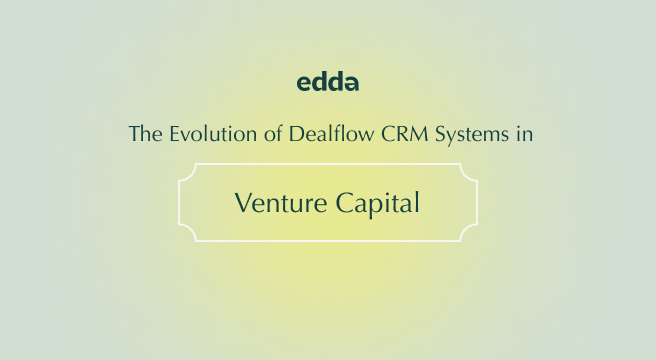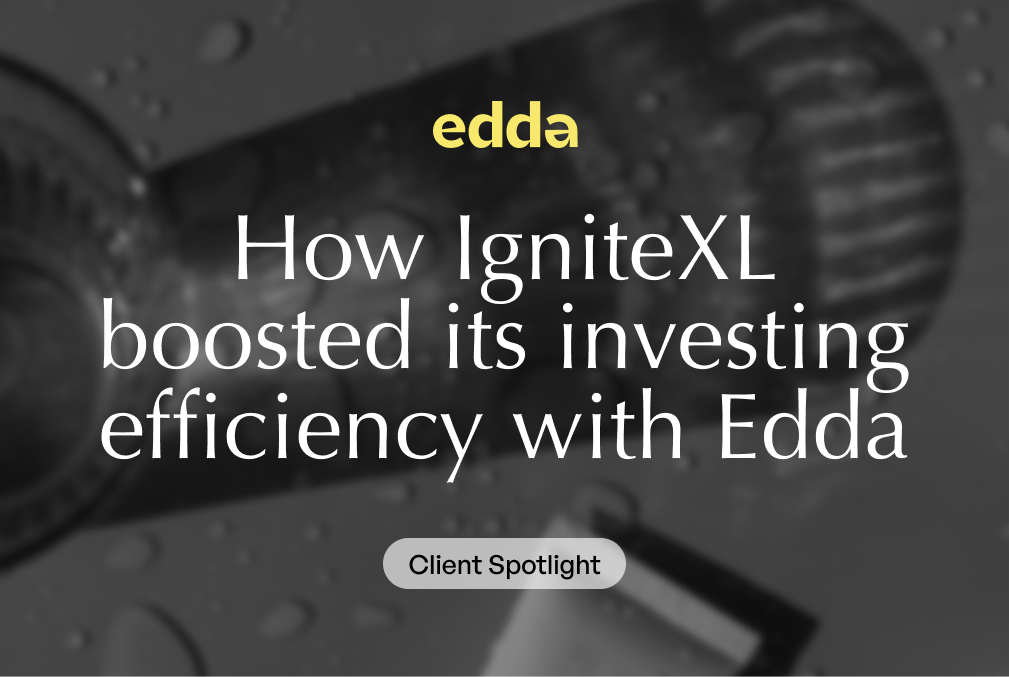The realm of venture capital (VC) is akin to navigating through a labyrinth of opportunities, and the tools one uses can make all the difference. Central to this navigation is the management of deal flow, the process of attracting, assessing, and finalizing potential investment opportunities. As the VC landscape grew more complex, so did the tools employed to manage this pivotal process. Let’s traverse the evolutionary journey of dealflow software.
The Humble Beginnings: Spreadsheets (1980s – Late 1990s)
In the embryonic phase of the venture capital industry, during the 1980s and the better part of the 1990s, simplicity was key. Spreadsheets, with Microsoft Excel gaining traction post its 1985 debut, quickly became the cornerstone for managing deal flow. Here’s a closer look at what the process was like:
Here’s how spreadsheets shaped deal flow:
Data Entry: Every potential deal started as a new row in a spreadsheet. Columns would denote various criteria such as the name of the startup, contact details, the industry it belonged to, initial impressions, and other pertinent information.
Evaluation and Scoring: VCs would often have columns dedicated to scoring different aspects of a startup—like team strength, product viability, market potential, etc. They’d input scores based on meetings, research, and due diligence.
Notes and Updates: As discussions with startups progressed, VCs would keep updating the relevant rows with new information, meeting notes, or changes in evaluations.
Status Tracking: Columns were often dedicated to track the status of each deal: whether it was in the initial discussion, due diligence, negotiation, or closed phase. This helped VCs get a quick snapshot of where each deal was in the pipeline.
Filtering and Searching: Using spreadsheet functionalities, VCs would filter and search for specific startups or deals based on various criteria, helping them quickly find and review the status or details of a potential investment.
Advantages:
Ubiquity: With the proliferation of personal computers, virtually every VC had access to spreadsheet software.
Flexibility: Each VC firm or even individual could customize their spreadsheet based on their preferences, adding or removing columns, setting up their formulas, or changing layouts to fit their unique evaluation criteria.
Limitations:
Manual Updates: Every piece of new information, every update, required manual entry. This not only was time-consuming but also posed the risk of human error.
Limited Collaboration: If two VCs were collaborating on a deal, they’d have to share the spreadsheet file back and forth, often leading to versioning issues. Two people couldn’t work on the same spreadsheet simultaneously without specialized software or setups.
Scalability Issues: As a VC firm’s deal pipeline grew, so did their spreadsheet. Over time, these sheets became cumbersome, slow, and challenging to navigate, especially when dealing with hundreds of potential investments.
The Dawn of Specialized CRMs (Late 1990s – Mid 2000s)
With the close of the 20th century and the onset of the digital age in the early 2000s, the venture capital landscape began to transform. The ubiquitous spreadsheets, though still prevalent, began to show their age, and their limitations became strikingly evident. This period marked the rise of specialized CRM for VCs tailored, albeit not perfectly, for the unique needs of VCs.
Here’s how specialized venture capital CRM systems shaped deal flow:
Data Integration: Rather than manually entering every piece of data, VCs could now integrate their CRM systems with other tools or databases. This allowed for automatic pulling of startup information from emails, contact lists, or even websites.
Interaction Tracking: Every meeting, call, or email with a startup could be logged and tracked. This ensured a chronological history of all interactions, providing VCs a comprehensive view of the relationship’s evolution.
Task and Reminder Setting: CRMs enabled VCs to set reminders for follow-ups, due diligence deadlines, or any other crucial tasks, ensuring no potential deal slipped through the cracks.
Dashboard Overview: Instead of scrolling through endless rows on a spreadsheet, VCs now had dashboards. These visual interfaces provided an at-a-glance view of the deal pipeline, highlighting critical metrics and deal statuses.
Customized Reporting: Beyond basic filters, these CRM systems allowed VCs to generate customized reports based on various criteria, helping in deeper analysis and better decision-making.
Advantages:
Centralization: CRMs provided a unified platform where all information related to a deal—interactions, notes, evaluations—was stored and could be accessed by anyone with the right permissions.
Automated Updates: The introduction of certain automated features reduced the dependency on manual data entry, minimizing human errors and saving time.
Advanced Filters and Searches: Locating specific deals or sorting through opportunities became much simpler, allowing VCs to focus on evaluation rather than navigation.
Limitations:
Generalization: While specialized, many of these CRMs were essentially adaptations of general-purpose CRMs with a VC twist. As a result, they sometimes missed nuanced features that would cater specifically to the VC workflow.
Cost: These CRM systems, especially the more sophisticated ones, came with a heftier price tag. This made them less accessible to smaller VC firms or individual investors, who might not have the budget for such advanced tools.
Emergence of Deal Flow Management Tools (Mid 2000s – Early 2010s)
As the venture capital industry matured, so did its requirements. By the mid-2000s, it became clear that generic CRMs, even if they were specialized to a degree, weren’t cutting it. The decade saw the inception and rise of dedicated deal flow management tools, designed ground-up for the unique dynamics of the VC world.
Here’s how dealflow management software shaped the deal flow process:
Automated Deal Sourcing: Instead of solely relying on networks or serendipity, these tools could automatically source potential deals from a variety of platforms, using criteria set by the VCs.
Dynamic Pipeline Visualization: Instead of static tables, VCs could visualize their deal pipeline in dynamic charts, making it easier to spot trends, gaps, or opportunities at a glance.
Stakeholder Collaboration Portals: These tools introduced collaboration platforms where all stakeholders, including investors, founders, and advisors, could communicate, share documents, and jointly evaluate opportunities.
Predictive Analytics: Advanced algorithms analyzed historical data to predict the success of potential deals, guiding VCs in their decision-making processes.
Centralized Documentation: All relevant documents, from pitch decks to term sheets, were stored centrally and were accessible to authorized individuals, streamlining the due diligence process.
Advantages:
Tailored Features: Unlike their predecessors, these tools were built specifically for VCs. This led to the introduction of features like automated deal sourcing, dynamic pipeline visualization, and collaborative portals tailor-made for stakeholder interactions.
Integration: The integration capabilities allowed these tools to pull data from, or push data to, other platforms. This interconnectedness streamlined various stages of the deal-making process, from sourcing to due diligence.
Data Analytics: With built-in analytics, VCs had a clearer view of their deal pipelines. They could spot trends, analyze performance, and make more informed, data-backed decisions.
Limitations:
Learning Curve: With increased sophistication came complexity. VCs and their teams had to invest time and sometimes resources to fully harness the capabilities of these tools.
Dependency: With such a robust tool at their disposal, there was a tendency to over-rely on the software. Some VCs risked becoming too formulaic, potentially overlooking outlier opportunities that didn’t fit neatly into predefined criteria or algorithms.
The Renaissance of Deal Flow CRM Systems (Late 2010s – Present)
As the technological landscape underwent seismic shifts with the proliferation of AI and machine learning in the late 2010s, the venture capital sector was not left behind. Today’s deal flow CRM systems represent the zenith of this evolution, synthesizing vast data with cutting-edge technology to offer unprecedented capabilities.
Here’s how deal flow CRM systems shaped the deal flow process:
AI-Driven Insights: Today’s CRMs are more than passive databases. They actively analyze data to provide insights. For instance, by studying the patterns of successful startups, these systems can suggest potential sectors or niches ripe for investment.
Real-time Collaboration Spaces: Modern CRM platforms offer cloud-based collaboration hubs where VCs, founders, and advisors can simultaneously discuss, evaluate, and even finalize deals. The barriers of geography and time zones have been effectively eliminated.
Enhanced Security Protocols: With cyber threats becoming more sophisticated, these CRMs have upped their game, employing encryption, two-factor authentication, and blockchain technologies to safeguard sensitive deal data.
Intelligent Deal Tracking: With machine learning, these systems can automatically track and categorize startups based on various criteria, ensuring VCs never miss out on potential golden opportunities.
Automated Reporting: Instead of manually generating reports, VCs can get automated, detailed, and customizable reports on their deal flow, performance metrics, and more.
Advantages:
Predictive Analysis: By harnessing the power of AI and machine learning, these CRM systems can forecast industry trends, detect potential unicorn startups, and even anticipate market shifts, positioning VCs always a step ahead.
Real-time Collaboration: The cloud-based nature of modern CRMs ensures instant data accessibility and modification. This real-time collaboration guarantees alignment among stakeholders, reducing errors and streamlining deal execution.
Security Enhancements: In an era of heightened cyber threats, the robust security features of these systems are not a luxury but a necessity. They ensure that sensitive deal-related data remains impregnable.
Limitations:
Over-reliance on Automation: The allure of automation can sometimes be a double-edged sword. By leaning too heavily on technology, there’s a risk that VCs might sideline the invaluable human intuition and judgment that have traditionally been the linchpins of successful deal-making. The art of venture capital, after all, isn’t solely about numbers but also about human potential and vision.
The Confluence of Technology & Venture Capital with Edda
The world of venture capital has witnessed a seismic shift in its modus operandi over the years. From the rudimentary spreadsheet beginnings to the sophisticated, AI-driven dealflow CRM systems of today, the journey has been marked by relentless innovation and the desire to optimize the deal-making process.
Edda’s portfolio management tool and CRM stands as a testament to this evolution. As an epitome of modern deal flow management, Edda seamlessly bridges the gap between data and decision-making, underscoring the significance of technology in amplifying human potential. It encapsulates the spirit of modern venture capital – nimble, data-driven, and laser-focused on maximizing opportunities without compromising the core human essence of the trade.
For VCs, navigating the vast ocean of potential startups and investment opportunities can be daunting. But with tools like Edda’s deal flow management software, the horizon seems clearer. It’s not just about managing data; it’s about refining instincts, bolstering judgments, and fostering a symbiotic relationship between man and machine for unparalleled venture success.









